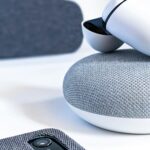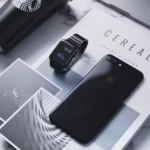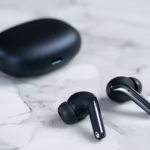The Samsung Galaxy Ring is Samsung’s foray into the world of smart rings, offering a compact yet powerful health-tracking device.
Here are the key details and specifications:
Design and Build
- Material: Constructed from Grade 5 titanium alloy, ensuring durability and a lightweight design.
- Colors: Available in Black, Silver, and Gold.
- Sizes: Comes in sizes 5 to 13 (U.S. ring sizes) and includes a free sizing kit for optimal fit.
- Dimensions: Varies by size, with the smallest (size 5) measuring 7.0 mm x 2.6 mm and weighing just 2.3 grams.
- Water Resistance: IP68-rated and 10ATM waterproof, making it suitable for swimming and harsh weather.
Health and Fitness Tracking
- Sensors: Includes a PPG heart rate sensor and a skin temperature sensor.
- Sleep Tracking: Offers detailed sleep tracking with features like Sleep Score, snoring analysis, and metrics for sleep latency, movement, and respiratory rate.
- Activity Tracking: Supports automatic workout detection, heart rate monitoring, and heart rate alerts.
- Cycle Tracking: Tracks menstrual cycles using temperature data.
- Energy Score: Combines sleep and activity data to generate an overall daily Energy Score out of 100.
Battery and Charging
- Battery Life: Up to 7 days of usage depending on the ring size. Smaller sizes (5-7) have 17 mAh batteries, while larger sizes (12-13) offer 22.5 mAh.
- Charging Case: Comes with a 361 mAh charging case that can recharge the ring up to 20 times.
Connectivity and Features
- Bluetooth 5.4: Connects via Bluetooth and works with Samsung Galaxy smartphones running Android 11 or later.
- Gesture Controls: Supports pinch gestures to take photos or silence alarms on Galaxy phones.
- Samsung Find: Built-in LED lights assist in locating the ring when misplaced.
- Software Integration: Seamlessly integrates with the Samsung Health app with no additional subscriptions needed.
Availability
- Release Date: Available for pre-order from July 10, 2024, with open sales beginning July 24, 2024.
The Galaxy Ring empowers users to track their health and fitness with precision—all in a sleek, minimalist form that eliminates the bulk of a smartwatch.
What are the differences between Samsung Galaxy Ring and other smart rings?
Here’s a detailed comparison table of the Samsung Galaxy Ring against other leading smart rings on the market, such as the Oura Ring (Gen 3), Ultrahuman Ring Air, and RingConn Smart Ring:
| Feature | Samsung Galaxy Ring | Oura Ring Gen 3 | Ultrahuman Ring Air | RingConn Smart Ring |
|---|---|---|---|---|
| Design | Titanium, concave design | Titanium, smooth design | Titanium, matte finish | Titanium, smooth finish |
| Sizes | US 5-13 | US 6-13 | US 5-14 | US 6-13 |
| Colors | Black, Silver, Gold | Silver, Black, Gold, Stealth | Black, Silver, Gold, Grey | Silver, Black, Gold |
| Weight | 2.3 – 3 grams | 4 – 6 grams | 2.4 – 3.6 grams | 3 – 4 grams |
| Water Resistance | IP68 + 10ATM (100m) | 100m depth | 100m depth | IP68 + 5ATM (50m) |
| Battery Life | Up to 7 days | Up to 7 days | Up to 6 days | Up to 7 days |
| Charging Case | Yes, with 20 recharges | Yes, up to 1 week | Yes, with USB-C | Yes, magnetic charger |
| Sensors | Heart rate, skin temperature | Heart rate, temperature, SpO₂ | Heart rate, temperature, SpO₂ | Heart rate, SpO₂, temperature |
| Health Tracking | Sleep, HR, activity, cycle tracking | Sleep, HR, activity, SpO₂ | Sleep, HR, metabolism, activity | Sleep, HR, activity, SpO₂ |
| Special Features | Gesture controls, Samsung Find | Readiness Score, period prediction | Metabolic insights, Strain Score | Continuous HR monitoring |
| App Compatibility | Samsung Health | Oura app | Ultrahuman app | RingConn app |
| Price | $399 | $299 + $5.99/month subscription | $349 | $279 |
| Release Date | July 2024 | 2021 | 2023 | 2023 |
Key Takeaways
- Samsung Galaxy Ring:
- Offers robust health tracking with a focus on integration within Samsung’s ecosystem.
- Unique features like gesture controls and Samsung Find.
- Strong waterproofing (IP68 + 10ATM), ideal for swimming and active users.
- Oura Ring Gen 3:
- Known for detailed sleep tracking and Readiness Scores.
- Requires a monthly subscription for advanced features.
- Ultrahuman Ring Air:
- Focuses on metabolic health and fitness with Strain Scores and recovery insights.
- No subscription fees, but priced higher.
- RingConn Smart Ring:
- Affordable option with continuous heart rate monitoring and no subscription fees.
- Slightly lower waterproof rating compared to the Samsung Galaxy Ring.
The choice between these rings largely depends on the user’s preference for ecosystems, specific health metrics, and willingness to pay for subscriptions. The Galaxy Ring excels in connectivity for Samsung device users, while the Oura Ring remains popular for its holistic health insights.
what is the best finger for wearing Samsung Galaxy Ring?
The Samsung Galaxy Ring can be worn on any finger depending on your comfort and preference. Samsung offers a sizing kit to help users determine the best fit for their fingers, as the ring is available in a wide range of sizes (US sizes 5 to 13).
Recommended Fingers:
- Index Finger: Provides more accurate tracking for gesture-based controls and is a popular choice for those who want accessibility for double-pinch gestures.
- Middle Finger: Offers stability and comfort, especially for daily wear.
- Ring Finger: A traditional placement, ensuring a snug fit without interfering with hand movements.
- Thumb or Pinky: Less common due to fit challenges but can be chosen for personal comfort.
Considerations for Wearing:
- Comfort: Samsung’s ergonomic design and titanium build help reduce pressure, allowing the ring to be worn comfortably for long periods.
- Accuracy: Sensors like heart rate monitors and temperature trackers are optimized for placement on larger fingers like the index or middle fingers for better skin contact.
- Water Use: With its IP68 and 10ATM waterproof rating, you can wear it while swimming, showering, or in rainy conditions.
Samsung’s Galaxy Ring is designed to be worn 24/7, offering health and sleep tracking without needing to be removed frequently.
When should you take off Samsung Galaxy Ring?
While the Samsung Galaxy Ring is designed for continuous wear, there are specific situations where it’s advisable to take it off to ensure durability, hygiene, and optimal sensor performance. Here are key scenarios when you should remove the Galaxy Ring:
1. During Heavy Impact Activities
- Reason: Activities like weightlifting, rock climbing, or contact sports can exert pressure on the ring, potentially damaging it or causing discomfort to your finger.
- Recommendation: Consider removing it to avoid damaging the titanium structure or injuring yourself.
2. When Handling Heavy Tools or Machinery
- Reason: Wearing the ring around machinery or tools can pose a safety risk (e.g., ring avulsion) or cause scratches on the ring’s surface.
- Recommendation: Remove the ring to prevent accidents or damage.
3. In Extreme Temperatures
- Reason: Prolonged exposure to extreme heat or cold (e.g., saunas, ice baths) could impact the ring’s materials or sensor accuracy.
- Recommendation: Take it off when in high-heat environments or freezing conditions.
4. During Certain Personal Care Activities
- Reason: Products like lotions, oils, or soaps can build up on the sensors, potentially affecting accuracy.
- Recommendation: Remove the ring when applying creams, oils, or during activities like exfoliating scrubs.
5. For Proper Cleaning and Maintenance
- Reason: Sweat, dirt, and skin oils can accumulate over time, affecting sensor performance.
- Recommendation: Periodically clean the ring by taking it off and gently wiping it with a soft, damp cloth.
6. Medical Procedures
- Reason: During procedures like MRI scans or X-rays, metal objects can interfere with equipment.
- Recommendation: Remove the ring to ensure safety and prevent interference.
7. If Experiencing Finger Swelling
- Reason: Swelling due to exercise, heat, or health conditions can cause discomfort or make removing the ring difficult.
- Recommendation: Take off the ring if you notice swelling to avoid it becoming too tight.
By following these guidelines, you can maximize the lifespan of the Samsung Galaxy Ring and ensure it functions effectively while minimizing risks.
How to size before purchasing?
To size your Samsung Galaxy Ring before purchasing, Samsung offers a Sizing Kit to ensure a perfect fit.

Here’s how to size it accurately:
- Order the Sizing Kit: When you place your order for the Galaxy Ring, you can request a free Sizing Kit if you’re unsure of your size. This kit includes dummy rings in all nine available sizes (from US size 5 to 13), which mimic the exact shape of the actual ring, including sensor bumps on the inside for a realistic fit.
- Choose the Right Finger: Samsung recommends wearing the Galaxy Ring on your index finger for the most accurate health-tracking performance and optimal use of gesture controls. However, the ring can be worn on other fingers as well if preferred.
- Wear the Dummy Ring: Try the sizing rings for at least 24 hours, including during sleep, to ensure they are comfortable over time and that they stay in place without being too tight or too loose.
- Indicator Alignment: Ensure that the indicator line on the ring faces your palm for proper sensor alignment.
Once you find the correct size, use the link provided in your confirmation email to finalize your order. This step is crucial because the Galaxy Ring’s interior design is unique due to its embedded sensors, making the sizing slightly different from regular rings.
How is the accuracy of detecting workouts?
The Samsung Galaxy Ring performs reasonably well in tracking workouts but has some limitations due to its form factor and sensor placement. It supports automatic workout detection for basic activities like walking and running, providing data such as heart rate, steps, and distance. However, accuracy can be inconsistent, especially during high-motion activities like running or weightlifting.
For example, in running tests, heart rate tracking was generally accurate, with maximum heart rate readings closely matching those from a chest strap. However, average heart rate results sometimes showed discrepancies, particularly when workouts were detected automatically rather than manually through the Samsung Health app. Distances recorded were also occasionally underestimated, with a 7.5 km run being logged as 7 km when relying on automatic detection. To get the best results, pairing with a smartphone for GPS-assisted tracking is recommended to improve distance and duration accuracy during workouts.
While it does a good job for casual workouts, the lack of a screen makes it less useful for real-time feedback compared to smartwatches. Additionally, it’s not ideal for strength training or high-impact activities, as there’s a risk of damaging the ring’s surface. Despite these limitations, it integrates well with the Samsung Health ecosystem, providing comprehensive data that contributes to its Energy Score feature, which summarizes overall fitness and recovery levels.
In short, the Galaxy Ring is effective for basic fitness tracking but isn’t suited for detailed, high-accuracy workout monitoring. It’s best for those who want a discreet way to track everyday activity and occasional runs rather than dedicated athletes or fitness enthusiasts needing precise metrics.












